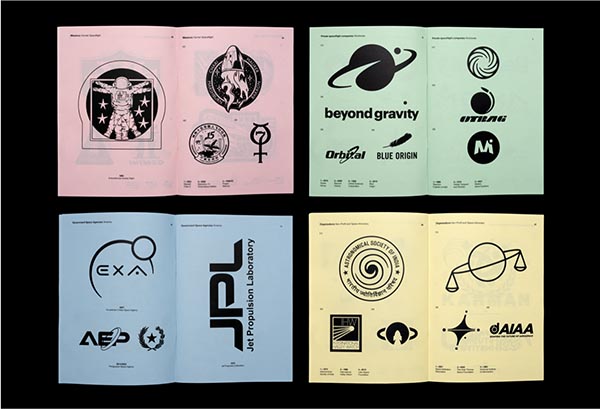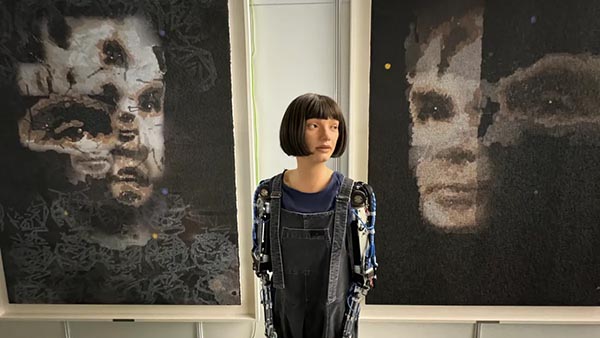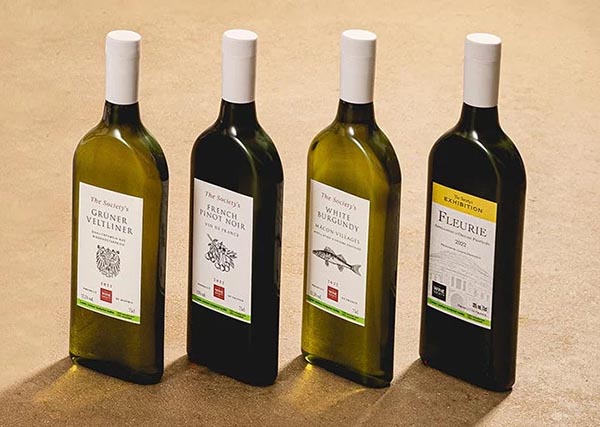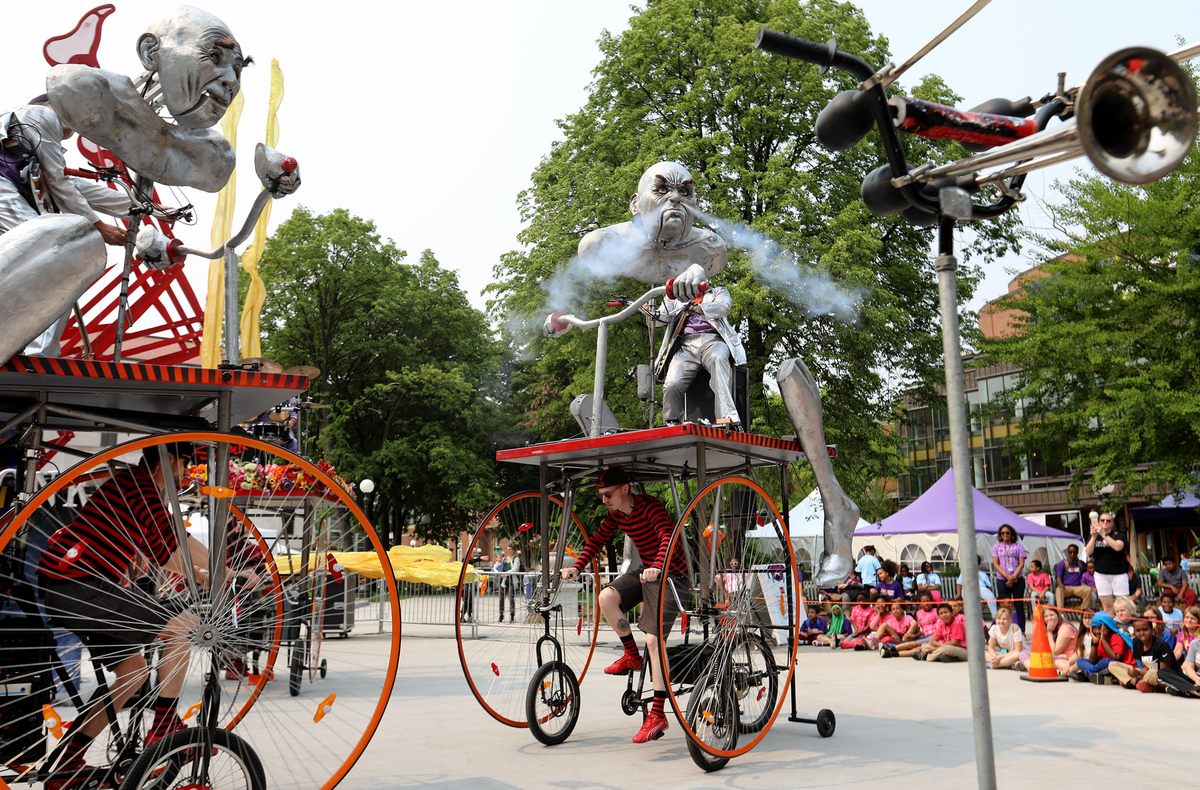
Que SELA SELA
Space travel is all the rage again. (Is it? Well, that’s the premise of this article at Print magazine, so we’ll fly with it.) Davide Mascioli, a Rome-based designer and art director, has set up a Kickstarter to help fund the Space Exploration Logo Archive (SELA). The project features more than 370 logos related to space exploration published in five separate booklets. The logos tell the visual story of space exploration from the 1940s to the present day.
Mascioli notes that SELA will be printed in risograph on natural recycled Fedrigoni paper, in collaboration with riso specialist Oreri. Along with the booklets, the project also includes space propaganda posters and a set of stickers featuring the most iconic logos. As a complement, Mascioli has launched an online archive with the logos in vector format, all free to download.

Were you surprised by how many space agencies and industries exist in the world?
Absolutely. My initial goal was to select only the best, prioritizing quality over quantity. I knew I would find a lot of material, but the more weeks went by, the more I kept adding dozens and dozens of logos. So, I went from an initial estimate of 150 logos to over 370!
I see you’ve included fictional logos as well. Is there a symbiotic relationship between real and fantasy?
Yes, very often science fiction anticipates future technologies, and sometimes even defines their aesthetics. That is why it seemed sensible and coherent to me to add this selection as well.
Happily, the project has been funded, drawing $6,349 pledged on a $2,701 goal. Far out.
AI-Yi-Yi, Part the Infinity + 1: But Is It Art?
It’s been a few years since we checked in with Ai-Da, the robot artist who bears a striking resemblance to Emo Phillips, but she was in the news—or at least the art news—this week as her work is up for auction at Sotheby’s. It’s titled, meta-ly enough, A.I. God. Portrait of Alan Turing (2024). Says The Art Newspaper:
The painting is estimated by Sotheby’s to sell for between $120,000 and $180,000 on 31 October. Fittingly, Sotheby’s will accept cryptocurrency for the transaction. Meller told CBS MoneyWatch that his share of proceeds will be reinvested back into the Ai-Da project.

As for Ai-Da herself:
Ai-Da, who was assigned a female gender, paints and draws using cameras in her eyes and robotic arms. She is usually shown wearing a short, dark wig and is often in denim overalls. Critics have commented that Ai-Da is particularly beautiful, with one writing she has “mysterious hazel eyes… magnificent lips… full and puffy, like a beckoning sofa”.
If that’s how he describes women, that critic had better stick with robots.
Bottle Episode
The UK’s Wine Society—a group of oenophiles—recently conducted a wine packaging study attempting to gauge what is the most sustainable kind of bottle. Via Core77, their findings may surprise you.

Yes, flat bottles made from ocean—i.e., recycled—plastic.
“Our packaging report showed that rPET bottles have a significantly lower carbon footprint than single-use glass bottles; they're less energy-intensive to make, smaller and less breakable than glass so can be packed more tightly, and of course significantly lighter (63g compared to an average of 453g for glass bottles).”
We’re gonna need to see the data on that one as the phrase “single-use” is doing a lot of the work there. Surely glass can be recycled many times and would seem to be a better option. Anyway, they add that the plastic doesn’t affect the flavor, but they recommend it only for wines with a shelf life of one year or less. So, top-notch wine.
Bringing (and Animating) the Receipts
Via Laughing Squid, filmmaker Sam Gainsborough created a cool advert for British grocery market Co-Op UK that “promotes the virtues of small business through a story told on cash register receipts.” It was created using actual receipts that were cut and animated by hand.
Inspired by black-and-white ink animation techniques, we used receipt paper and thousands of letters, numbers, and symbols to form a distinct typography aesthetic. Our incredible team printed and cut each frame of the film through a receipt printer, and all the frames were then animated in stop-motion (899 in total !), bringing out all the beautifully unique textures and imperfections made possible by traditionally handcrafted techniques
Try that with an e-receipt.
Ghost In the Machine
Some years ago, when we rented our cable modem through the cable company (before sensibly buying our own), it needed to be replaced and it was swapped with a used one—and one whose previous owner apparently had contracted every computer virus on Earth. As a result, it was blocked by many many sites making it impossible to accomplish anything online. (At least that was what the cable guy said. We never knew that could be a thing.)
Likewise, something else we never knew was that a domain could be “haunted.” Boing Boing helpfully points out that if you buy a cool sounding domain name, if it had previously been host to questionable activity, it may get blacklisted by various Internet services.
Domain marketplaces won’t warn you if, say, moist.li was previously host to questionable content or the origin of unpleasant network activity. And if it was, you’re not going to be able to sign up for useful services, you’re not going to be ranked highly in search engines, and you’re definitely not going to be delivering email from it.
They also provide a cautionary tale from a site owner who needed to perform the online equivalent of an exorcism. (No, not on lindablair.com.)
I had no idea, of course. It wasn't until I had redirected all of my musicboxfun.com traffic to musicbox.fun that I noticed that something wasn't right: my web traffic from organic search dropped to zero.
I assumed it was temporary so I double-checked my process and waited for awhile, but it never really recovered. It wasn't until a year later that I discovered the copyright violations and learned that the domain name was compromised.
Apparently, this is a thing that happens to domain names, but as far as I know, there's not really a name for it. When I described it to my wife, she said "Oh, so it's haunted."
How to see if your potential new domain is haunted?
check the domain's web history at the Wayback Machine, search for DMCA complaints and domain history reports at SEO sites, check email blacklists, and be prepared to "wait for a while" while you commit to best practices.
Print never had this kind of problem.
The Stakes Were High
Hey, look what we found! “Archaeologists reconstruct face of 400-year-old “vampire” buried with iron sickle across her neck.” Says CBS News:
Two years ago, archaeologists in Poland made a discovery at a gravesite they could only describe as "astonishing" — the remains of a woman with a sickle around her neck and a triangular padlock on her foot.
She had apparently been deemed a vampire and the sickle and padlock were traditional; precautions to keep her from rising from the dead. It’s best to be safe. A tragic fate, but now scientists have given “Zosia” a face.
A research team from the Nicolaus Copernicus University in Torun made the unique discovery in August 2022, and working with Swedish archaeologist Oscar Nilsson, the team used DNA, 3D printing and clay to reconstruct the face of Zosia, as she was called by locals.

Ooh, she does look terrifying.
“It’s really ironic, in a way,” Nilsson told the Reuters news agency. “These people burying her, they did everything they could in order to prevent her from coming back from the dead ... we have done everything we can in order to bring her back to life.”
Heh. Let’s hear it for Zosia!
A Trick of the Tail
Fans of post-Peter Gabriel Genesis (or Steely Dan’s “Any Major Dude Will Tell You”) may be familiar with a cryptid called a squonk. Said to live in the wilderness of Pennsylvania, it is apparently so ugly—and so aware of how ugly it is—that it weeps constantly, and avoids still waters lest it be confronted by its own hideous reflection. Pursuers can supposedly follow a trail of tears, but it eludes capture by dissolving into a pool of tears if caught. Mind you, we do not condone squonk-shaming.
Ostensibly first spotted by lumberjacks working in what is today known as Tuscarora State Forest, the squonk was first described on paper by William T. Cox in the 1910 book Fearsome Creatures of the Lumberwoods, where he gives it the scientific name Lacrimacorpus dissolvens. The squonk is a staple of Pennsylvania lore and there is apparently a Pittsburgh-based performance art troupe called Squonk Opera.
It is apparently such a specifically local legend that outside Pennsylvania only hardcore old Genesis fans have ever heard of it—and for years thought the band had made it up. But, via Atlas Obscura, squonk fans are trying to give the critter a bit more renown with a new festival.
Lisa Russell, founder of Cryptid Comforts, and Joe Fogle, owner of Cryptoteeology, are both vendors who frequent cryptid events across the country, which sparked an idea. “Joe and I were talking one day, and I mentioned I’d like there to be a Squonk Fest,” says Russell. “He said, ‘Let’s do it!’”
And last year, their dream did not dissolve in tears.
So in August 2023, fans of Appalachian folklore and cryptozoology descended on Johnstown for the first-ever Squonkapalooza. In addition to more than 60 vendor booths, the event activities included a squonk compliment contest, a squonk quest, games, music, and lectures on topics ranging from Pennsylvania lore to whether Bigfoot exists. A costumed squonk even tried its hand at hula-hooping.
Although conceived as a one-time thing, it apparently drew such a crowd—and from out of state—that it is now an annual event.
The second Squonkapalooza took place August 10, 2024, and it proved equally popular, with hundreds of visitors perusing the vendor stands in Johnstown’s Central Park and watching lectures, podcast recordings, and movie screenings in the State Theater. The 2024 event extended beyond the festival’s official hours, with music and cryptid trivia the Friday before and an afterparty at nearby Fetz’s Sports Pub. The organizers hope to keep it going for years to come.

It is also a big morale boost for Johnstown, which is still haunted by the 1889 flood.
…By turning the squonk into a reason to smile, Squonkapalooza encourages Johnstown and its visitors to make peace with their own insecurities and imperfections—all while bringing some overdue recognition to a long-neglected local legend.
Graphene Scoots Along
Was it a good week for graphene news? It’s always a good week for graphene news! An electric scooter that uses a graphene-based battery. From (who else?) Graphene-Info:
It was reported that Indian electric vehicle brand Komaki has introduced the new model of Cat 3.0 NXT that comes with two battery variants, Graphene and LIPO4, and will be available for Rs. 1,19,999 (around USD$1400) and Rs. 1,49,999 (almost USD$1800). The unveiling of this EV is aimed at last-mile delivery operators, enabling sustainable all-day use and supporting SMEs and MSMEs in growing their businesses.
But caveat emptor:
While there have already been declarations of similar products using graphene-enhanced batteries, like another India-based EV startup called iVOOMi that launched the S1 Lite, an electric scooter available with two battery options, Graphene and Li-ion, no real details were given on these batteries and it should be interesting to see what sort of batteries are actually used.
Turning Over Lots of New Leaves
Yes, it’s that most wonderful time of year, when those of who have lawns and trees need to deal with leaves, wondering if Saruman didn’t have the right idea vis-à-vis deforestation.
However, via Core77, a unique way of dealing with autumn’s detritus: a leaf blower mounted to a robot dog, the brainchild of Enginerdz, who has named the system Yardwork.

Why the Pringles can? Sure, once you pop you can’t stop, but even so:
“It was the closest thing in my shed I found,” Enginerdz writes, “to help prop up the blower, to angle the nozzle down and hold it on position.”
Learn to Be a Bat in 10 Weeks!
Have you ever wished you could navigate the world like a bat—that is, use echolocation to move about? (It would be helpful when getting up in the middle of the night in an unfamiliar hotel room to keep from blundering into walls or furniture.) Via Scientific American, it’s not out of the realm of possibility.
People who are visually impaired have long demonstrated the ability to echolocate, allowing them to ride bikes, play basketball, etc.
Brain-imaging studies reveal that expert echolocators display responses to sound in their brain’s primary visual region, and researchers have speculated that long-term input deprivation could lead to visual regions being repurposed. “There’s been this strong tradition to think of the blind brain as different, that it’s necessary to have gone through that sensory loss to have this neuroplasticity,” says Lore Thaler, a neuroscientist at Durham University in England.
Sometimes called “acoustic wayfinding,” the process is very similar to the way bats use echolocation. A visually impaired person taps a cane, stamps a foot, or makes clicking noises with the mouth, and can interpret the sound waves as they bounce off nearby objects and are reflected back. Individuals skilled in echolocation can pretty accurately determine the location and size of an object. And indeed Thaler helmed a study in 2021 that demonstrated how both blind and sighted people could learn this form of echolocation with just 10 weeks of training.
The researchers trained 14 sighted and 12 blind people for between two and three hours twice a week over 10 weeks. They started by teaching participants to produce mouth clicks, then trained them on three tasks. The first two involved judging the size or orientation of objects. The third involved navigating virtual mazes, which participants moved through with the help of simulated click-plus-echo sounds tied to their positions. Both groups improved on all the tasks
In the 19th century, there was a famous example of acoustic wayfinding. James Holman (1786–1857) was the so-called “Blind Traveler” who, despite being completely blind, was a British adventurer who traveled the globe at a time when such journeys were rare even among the sighted, and wrote extensively about his exploits. He got around using “human echolocation.”
As a young man, Holman served in the Royal Navy, rising to the rank of lieutenant. He spent more than a decade patrolling the waters of the North Atlantic, where, thanks to the often freezing cold, he contracted rheumatism. It afflicted his joints so badly he became unable to walk. Thus, at age 25, his naval career was ended. And if that weren’t bad enough, as he was trying to recuperate, his eyesight, for mysterious reasons, but believed to be related to the rheumatism, rapidly deteriorated until he was completely blind. So, blind and nearly crippled, what did he do? Of course: go on tour of Europe! So, between 1819 and 1821, he hobbled through France, Italy, Switzerland, Germany, Belgium, and the Netherlands, returning to publish the succinctly tiled The Narrative of a Journey, Undertaken in the Years 1819, 1820 & 1821, Through France, Italy, Savoy, Switzerland, Parts of Germany Bordering the Rhine, Holland, and The Netherlands in 1822.
As if that weren’t enough, he then decided to embark on a round-the-world journey, although his trip was curtailed in Russia when he was suspected by the czar of being a spy. When he returned in 1825, he published the even more succinctly titled Travels through Russia, Siberia, Poland, Austria, Saxony, Prussia, Hanover & & Undertaken During the Years 1822, 1823 and 1824, While Suffering from Total Blindness and Comprising an Account of the Author being Conducted a State Prisoner from the Eastern Parts of Siberia. Holman continued his travels, and by the time he died in 1857 at the age of seventy, is estimated to have traveled more than a quarter of a million miles in his lifetime.
His secret to success is that he never had to fly Delta.
Pretty As a Train Station?
Douglas Adams’ 1988 novel The Long Dark Tea-Time of the Soul opens with the line, “It can hardly be a coincidence that no language on Earth has ever produced the expression ‘as pretty as an airport.’” He has a point. But a train station? No, those can be pretty spectacular. And Atlas Obscura rounds up 15 “stunning train stations,” from Bangkok Rail Way Station in Thailand, to Antwerpen-Centraal Railway Station in Belgium, to Kyoto Station in Japan. Any US stations? Union Terminal in Cincinnati.

What’s your favorite train station?
Get Your Kicks
This is either a great idea for parents who can’t keep their kids in shoes, or some form of child abuse, although it can be a fine line. Via Core77, footwear designer Dr. D’Wayne Edwards has designed ÜNOS by Sz, a line of sneakers that grow with your kids. Huh?

The sole is divided by a Z shape, which allows the shoe to expand, in length and width, up to a half-size (or a full size in the adult sizes, if your kid's got big feet). This allows parents to get a little extra bang for their buck, rather than having to buy new kicks to replace outgrown ones.

Seems like a good idea…or a potential source of a lifetime of foot problems.
What Will You Have?
What will you be eating in 2025? Haven’t decided yet? Well, we’ll tell you. Whole Foods, via (who else?) Food & Wine, has come out with their food trends 2025. What’s on the menu next year?
Come 2025, you’ll be boiling sourdough pasta, hosting tea parties, and sprinkling seaweed salt on everything, according to Whole Foods’ just-released trends report.
We think it’s a safe bet that we will be doing exactly none of those things in 2025 or ever. So how did they come to these conclusions?
To determine its 10th annual list of anticipated food and drink trends, the Austin-based retailer — known for its ethically sourced groceries and stellar baked goods — relied on a council of more than 50 employees, ranging from floor members to senior vice presidents. “The bottom line is we are food lovers who are culinarily inquisitive,” says Cathy Strange, Whole Foods’ ambassador of culture and a team member since 1990 who previously worked as the grocer’s global cheese buyer. “We’re always questioning and searching, compiling and communicating.”
And while real-life experiences inform the team’s predictions, other factors are considered as well. Among these influences, the council takes inspiration from members’ personal travels, trade groups (Strange herself is a member of Les Dames d’Escoffier International), and informal conversations with suppliers and partners.
Mercifully, they did not rely on social media.
Less important, according to Strange? Social media platforms such as TikTok and Instagram. “Social media is used as a level of validation,” she says. “We’re focused not on what’s already out there now, but what could be out there.”
And we can tell they didn’t rely on AI to come up with these trends as none them involved glue on pizza.
This Week in Printing, Publishing, and Media History
October 28
1726: The novel Gulliver’s Travels by Jonathan Swift is published.
1886: In New York Harbor, President Grover Cleveland dedicates the Statue of Liberty. The first ticker tape parade takes place in New York City when office workers spontaneously throw ticker tape into the streets as the statue is dedicated.
1899: German-American engineer, invented the Linotype machine Ottmar Mergenthaler dies (b. 1854).
October 29
1675: Leibniz makes the first use of the long s (∫) as a symbol of the integral in calculus.
1787: Mozart’s opera Don Giovanni receives its first performance in Prague.
1911: Hungarian-American publisher, lawyer, and politician, founded Pulitzer, Inc. Joseph Pulitzer dies (b. 1847).
1969: The first-ever computer-to-computer link is established on ARPANET, the precursor to the Internet.
October 30
1466: German printer Johann Fust dies (b. c. 1400).
1885: American poet Ezra Pound born.
1938: Legitimately fake news—Orson Welles broadcasts his radio play of H. G. Wells’ The War of the Worlds, causing anxiety in some of the audience in the United States.
October 31
1795: English poet John Keats born.
1941: After 14 years of work, Mount Rushmore is completed.
1963: English singer-songwriter and guitarist Johnny Marr born.
1993: Italian director and screenwriter Federico Fellini dies (b. 1920).
2000: American journalist and screenwriter Ring Lardner, Jr. dies (b. 1915).
November 1
1512: The ceiling of the Sistine Chapel, painted by Michelangelo, is exhibited to the public for the first time.
1604: William Shakespeare’s tragedy Othello is performed for the first time, at Whitehall Palace in London. A few years later...
1611: Shakespeare’s play The Tempest is performed for the first time, again at Whitehall Palace in London.
1941: American photographer Ansel Adams takes a picture of a moonrise over the town of Hernandez, New Mexico that would become one of the most famous images in the history of photography.

1968: The Motion Picture Association of America's film rating system is officially introduced, originating with the ratings G, M, R, and X.
1972: American poet and critic Ezra Pound dies (b. 1885).
November 2
1920: KDKA of Pittsburgh starts broadcasting as the first commercial radio station.
1936: The British Broadcasting Corporation initiates the BBC Television Service, the world’s first regular, “high-definition” (then defined as at least 200 lines) service. It was renamed BBC1 in 1964.
1950: Irish author, playwright, critic, and Nobel Prize laureate George Bernard Shaw dies (b. 1856).
1960: Penguin Books is found not guilty of obscenity in the trial R v Penguin Books Ltd, the Lady Chatterley’s Lover case.
1961: American humorist and cartoonist James Thurber dies (b. 1894).
1988: The Morris worm, the first Internet-distributed computer worm to gain significant mainstream media attention, is launched from MIT.
November 3
1838: The Times of India, the world’s largest circulated English language daily broadsheet newspaper, is founded as The Bombay Times and Journal of Commerce.















Discussion
Only verified members can comment.